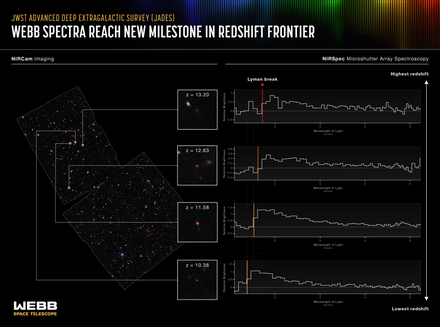High-redshift Lyman-break galaxy that is one of the oldest galaxies known
JADES-GS-z13-0 is a high-redshift Lyman-break galaxy discovered by the James Webb Space Telescope (JWST) during NIRCam imaging for the JWST Advanced Deep Extragalactic Survey (JADES) on 29 September 2022. Spectroscopic observations by JWST's NIRSpec instrument in October 2022 confirmed the galaxy's redshift of z = 13.2 to a high accuracy, establishing it as the oldest and most distant spectroscopically-confirmed galaxy at the time, with a light-travel distance (lookback time) of 13.4 billion years.[4][3] Due to the expansion of the universe, its present proper distance is approximately 33 billion light-years.[5] In 2024, two older and more distant galaxies, JADES-GS-z14-0 and JADES-GS-z14-1, were found.[6]
JADES-GS-z13-0 is located in the Great Observatories Origins Deep Survey – South (GOODS-S) field in the constellation Fornax, which includes the Hubble Ultra Deep Field.[1][7]
 James Webb Space Telescope NIRSpec spectra of four high-redshift galaxies including JADES-GS-z13-0
James Webb Space Telescope NIRSpec spectra of four high-redshift galaxies including JADES-GS-z13-0
See also
References
- ^ a b c d e f g h Robertson, B. E.; et al. (2023). "Identification and properties of intense star-forming galaxies at redshifts z > 10". Nature Astronomy. 7 (5): 611–621. arXiv:2212.04480. Bibcode:2023NatAs...7..611R. doi:10.1038/s41550-023-01921-1. S2CID 257968812.
- ^ Wright, Edward L. (2022). "Ned Wright's Javascript Cosmology Calculator". University of California, Los Angeles. Retrieved 24 November 2022. (H0=67.4 and OmegaM=0.315 (see Table/Planck2018 at "Lambda-CDM model#Parameters" )
- ^ a b c Curtis-Lake, Emma; et al. (December 2022). "Spectroscopy of four metal-poor galaxies beyond redshift ten" (PDF). Nature. arXiv:2212.04568.
- ^ Cesari, Thaddeus (9 December 2022). "NASA's Webb Reaches New Milestone in Quest for Distant Galaxies". Retrieved 9 December 2022.
- ^ Carpineti, A. (9 December 2022). "JWST Confirms One Of The Furthest Galaxies Ever Discovered". IFLScience. Retrieved 7 April 2024.
- ^ Peña, Mike (30 May 2024). "Earliest, most distant galaxy discovered with James Webb Space Telescope". University of California, Santa Cruz News. Retrieved 31 May 2024.
- ^ Shen, Zili (16 December 2022). "JWST smashes the record for the earliest galaxy". Astrobites. Retrieved 16 December 2022.
|
|---|
|
Instruments
and sensors | | |
|---|
| Elements | |
|---|
| Stages | |
|---|
| Images | |
|---|
| Discoveries | |
|---|
| Institutions | |
|---|
| Related | |
|---|
|